A Heme Propionate Staples the Structure of Cytochrome c for Methionine Ligation to the Heme Iron
- PMID: 31589413
- PMCID: PMC7458101
- DOI: 10.1021/acs.inorgchem.9b02111
A Heme Propionate Staples the Structure of Cytochrome c for Methionine Ligation to the Heme Iron
Abstract
Ligand-switch reactions at the heme iron are common in biological systems, but their mechanisms and the features of the polypeptide fold that support dual ligation are not well understood. In cytochrome c (cyt c), two low-stability loops (Ω-loop C and Ω-loop D) are connected by the heme propionate HP6. At alkaline pH, the native Met80 ligand from Ω-loop D switches to a Lys residue from the same loop. Deprotonation of an as yet unknown group triggers the alkaline transition. We have created the two cyt c variants T49V/K79G and T78V/K79G with altered connections of these two loops to HP6. Electronic absorption, NMR, and EPR studies demonstrate that at pH 7.4 ferric forms of these variants are Lys-ligated, whereas ferrous forms maintain the native Met80 ligation. Measurements of protein stability, cyclic voltammetry, pH-jump and gated electron-transfer kinetics have revealed that these Thr to Val substitutions greatly affect the alkaline transition in both ferric and ferrous proteins. The substitutions modify the stability of the Met-ligated species and reduction potentials of the heme iron. The kinetics of ligand-switch processes are also altered, and analyses of these effects implicate redox-dependent differences in metal-ligand interactions and the role of the protein dynamics, including cross-talk between the two Ω-loops. With the two destabilized variants, it is possible to map energy levels for the Met- and Lys-ligated species in both ferric and ferrous proteins and assess the role of the protein scaffold in redox-dependent preferences for these two ligands. The estimated shift in the heme iron reduction potential upon deprotonation of the "trigger" group is consistent with those associated with deprotonation of an HP, suggesting that HP6, on its own or as a part of a hydrogen-bonded cluster, is a likely "trigger" for the Met to Lys ligand switch.
Figures
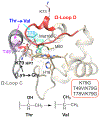


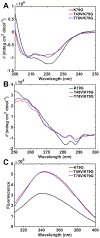
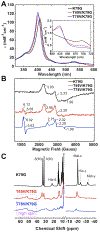



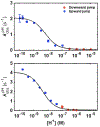
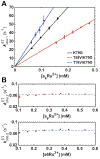
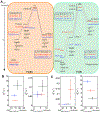



Similar articles
-
Ligation and Reactivity of Methionine-Oxidized Cytochrome c.Inorg Chem. 2018 May 21;57(10):5754-5766. doi: 10.1021/acs.inorgchem.8b00010. Epub 2018 Apr 30. Inorg Chem. 2018. PMID: 29708337 Free PMC article.
-
Remote Perturbations in Tertiary Contacts Trigger Ligation of Lysine to the Heme Iron in Cytochrome c.Biochemistry. 2017 Jun 13;56(23):2950-2966. doi: 10.1021/acs.biochem.6b01187. Epub 2017 May 31. Biochemistry. 2017. PMID: 28474881 Free PMC article.
-
Naturally Occurring Disease-Related Mutations in the 40-57 Ω-Loop of Human Cytochrome c Control Triggering of the Alkaline Isomerization.Biochemistry. 2018 Jul 24;57(29):4276-4288. doi: 10.1021/acs.biochem.8b00520. Epub 2018 Jul 11. Biochemistry. 2018. PMID: 29949346
-
The folding energy landscape and free energy excitations of cytochrome c.Acc Chem Res. 2010 May 18;43(5):652-60. doi: 10.1021/ar9002703. Acc Chem Res. 2010. PMID: 20143816 Free PMC article. Review.
-
Heme-Protein Interactions and Functional Relevant Heme Deformations: The Cytochrome c Case.Molecules. 2022 Dec 9;27(24):8751. doi: 10.3390/molecules27248751. Molecules. 2022. PMID: 36557884 Free PMC article. Review.
Cited by
-
Disabling the Entatic Control of Methionine Ligation through Additive Destabilization of Ferric Cytochrome c.Inorg Chem. 2025 Jun 23;64(24):11966-11980. doi: 10.1021/acs.inorgchem.5c00839. Epub 2025 Jun 11. Inorg Chem. 2025. PMID: 40498030 Free PMC article.
-
Phosphorylation of cytochrome c at tyrosine 48 finely regulates its binding to the histone chaperone SET/TAF-Iβ in the nucleus.Protein Sci. 2024 Dec;33(12):e5213. doi: 10.1002/pro.5213. Protein Sci. 2024. PMID: 39548742 Free PMC article.
-
The importance of Asn52 in the structure-function relationship of human cytochrome c.RSC Adv. 2020 Dec 18;10(73):44768-44772. doi: 10.1039/d0ra09961a. eCollection 2020 Dec 17. RSC Adv. 2020. PMID: 35516242 Free PMC article.
-
The Role of the Hydrogen Bond Network in Maintaining Heme Pocket Stability and Protein Function Specificity of C. diphtheriae Coproheme Decarboxylase.Biomolecules. 2023 Jan 25;13(2):235. doi: 10.3390/biom13020235. Biomolecules. 2023. PMID: 36830604 Free PMC article.
-
Distal Unfolding of Ferricytochrome c Induced by the F82K Mutation.Int J Mol Sci. 2020 Mar 20;21(6):2134. doi: 10.3390/ijms21062134. Int J Mol Sci. 2020. PMID: 32244917 Free PMC article.
References
-
- Biological Inorganic Chemistry: Structure and Reactivity; Bertini I; Gray HB; Stiefel EI; Valentine JS, Eds.; University Science Books: Sausalito, CA, 2007.
-
- Mao J; Hauser K; Gunner MR How cytochromes with different folds control heme redox potentials. Biochemistry 2003, 42, 9829–9840. - PubMed
-
- Hunter CL; Lloyd E; Eltis LD; Rafferty SP; Lee H; Smith M; Mauk AG Role of the heme propionates in the interaction of heme with apomyoglobin and apocytochrome b5. Biochemistry 1997, 36, 1010–1017. - PubMed
-
- Louro RO; Bento I; Matias PM; Catarino T; Baptista AM; Soares CM; Carrondo MA; Turner DL; Xavier AV Conformational component in the coupled transfer of multiple electrons and protons in a monomeric tetraheme cytochrome. J. Biol. Chem 2001, 276, 44044–44051. - PubMed
MeSH terms
Substances
Grants and funding
LinkOut - more resources
Full Text Sources
Medical
Research Materials
Miscellaneous

